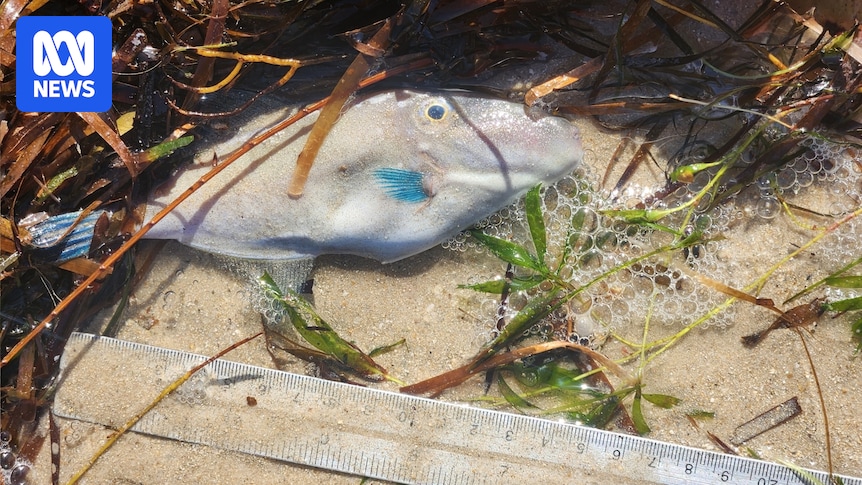Each day for the past two weeks, Johanna Williams has walked a stretch of Adelaide’s coast with a metal ruler and smartphone in hand.
Feeling helpless amid the state’s ongoing toxic algal bloom, she decided to start documenting the impact on her local beach.
Johanna Williams says she’s made more than 1,000 observations of dead sea creatures along a 500-metre stretch. (ABC News: Ashlin Blieschke)
She had no idea that in such a short time she would make more than 1,000 observations of dead sea creatures along a 500-metre stretch of the Glenelg shoreline.
“I try to get out here along the shore once every day … I’ve been making a point of coming along the beach,” Ms Williams said.
Ms Williams said she found this creature, which she described as a western talma, not far from the Glenelg jetty. (Creative commons/iNaturalist: johanna13501)
“I got back from holidays 12 days ago. I was absolutely gutted to see all the dead fish on here.
“So, I guess to shift my sense of despair I thought, ‘What can I do? I’ll get out here, I’ll take photos and upload them to iNaturalist.'”
Ms Williams said she found “hundreds” of what were described as staircase abalone along the beach. (Creative commons/iNaturalist: johanna13501)
Ms Williams, who is an occupational therapist by trade, said she had learned a lot about different species since she began contributing to the citizen science site about a fortnight ago.
“I started on the 26th of July … along the 500-metre strip between Pier Street and the south side of the jetty, pretty much walking once a day,” she said.
“I’ve uploaded 1,003 different observations.”
This find was documented as a Gunn’s six-armed star. (Creative commons/iNaturalist: johanna13501)
Among them, Ms Williams has identified 113 species.
“My knowledge of the sea has just expanded,” she said.
“I would have never have guessed in a million years I would find so many different things.”
This fish, described on iNaturalist as a bluefin leatherjacket, was found washed up along the beach at Glenelg. (Creative commons/iNaturalist: johanna13501)
Devastation is ‘deeply concerning’
Ms Williams is among hundreds of South Australians who have joined the citizen science movement.
More than 20,000 observations have been uploaded to the SA Marine Mortality Monitoring Project since the bloom began in March.
“It’s deeply concerning, it’s devastating. I feel quite upset by it,” she said.
Ms Williams documented this creature as a bluespotted goatfish. (Creative commons/iNaturalist: johanna13501)
Ms Williams said her thoughts had also turned to the “health concerns, and just even people’s recreation”.
“You can’t go out and fish anymore,” she said.
“You just think … of how the commercial fishing industry is affected, how the cafes and all that are affected, when people don’t come down, [and] the tourism.”
Johanna Williams is among hundreds of South Australians who have joined the citizen science movement. (ABC News: Ashlin Blieschke)
Testing ‘reflective of the images’, premier says
On Thursday, SA Premier Peter Malinauskas said the bloom had worsened in some areas, but had improved in others, with 27 per cent of the state’s coastline impacted.
He said authorities were now conducting testing at 76 different locations for Karenia mikimotoi, and were carrying out separate tests for brevetoxins near oyster and mussel harvesting sites.
“What we have seen with the 76 locations is that in many of them, the algae presence has gone up, and in many of them they have gone down — which is very much a demonstration of the pulsating nature of the algal bloom,” Mr Malinauskas told a media conference on Thursday.
This fish was described on iNaturalist as a blue weed-whiting. (Creative commons/iNaturalist: johanna13501)
“The algal bloom is constantly moving, it’s not stationary.
“It will pulsate as the conditions around it change.”
He said there were 17 sites being tested in metropolitan Adelaide waters.
Among the many finds was what was described as a granular sea star. (Creative commons/iNaturalist: johanna13501)
“Of those 17 sites, we saw an increase in eight of them and a decrease in nine … so one down more than there’s one up,” he said.
“But I don’t think that allows us to say it’s going away.
“It is proving to be persistent and that sort of is reflective of the images we’ve seen of the fish deaths on our metro beaches yesterday.”
A seadragon was among the creatures documented by Ms Williams. (Creative commons/iNaturalist: johanna13501)
Mr Malinauskas said among the small glimmers of hope was the fact that 100 per cent of mussel farms were in operation, with the brevetoxin clearing in Boston Bay, Brickers Island and the lower Eyre Peninsula in and around Port Lincoln.
He said 10 per cent of the oyster industry was closed, and the remaining 90 per cent was open.
These creatures were described on iNaturalist as a Gunn’s six-armed star, a rough bullseye and a smooth toadfish. (Creative commons/iNaturalist: johanna13501)
Artificial reef to be established in Gulf St Vincent
These creatures were described on iNaturalist as a longhead flathead and an estuary cobbler. (Creative commons/iNaturalist: johanna13501)
Earlier this week, the state government announced it would create a new artificial reef off the South Australian coast to help the state’s recreational fishing sector battle the ongoing impacts of the algal bloom.
The $300,000 reef is part of $28 million in state and federal government funding.
One of the hundreds of dead creatures that was found by Ms Williams along the beachfront. (Creative commons/iNaturalist: johanna13501)
“The idea of re-establishing reefs as soon as we see this bloom pass is a really important one,” SA Environment Minister Susan Close said on Sunday.
“The faster we can accelerate that recovery, the faster we’ll all be able to move past the experience of this bloom and also make ourselves more resilient in the event that it returns.”

